Abstract
Objective
To construct growth curves for school-aged children and adolescents that accord with the WHO Child Growth Standards for preschool children and the body mass index (BMI) cut-offs for adults.
Methods
Data from the 1977 National Center for Health Statistics (NCHS)/WHO growth reference (1–24 years) were merged with data from the under-fives growth standards’ cross-sectional sample (18–71 months) to smooth the transition between the two samples. State-of-the-art statistical methods used to construct the WHO Child Growth Standards (0–5 years), i.e. the Box-Cox power exponential (BCPE) method with appropriate diagnostic tools for the selection of best models, were applied to this combined sample.
Findings
The merged data sets resulted in a smooth transition at 5 years for height-for-age, weight-for-age and BMI-for-age. For BMI-for-age across all centiles the magnitude of the difference between the two curves at age 5 years is mostly 0.0 kg/m² to 0.1 kg/m². At 19 years, the new BMI values at +1 standard deviation (SD) are 25.4 kg/m² for boys and 25.0 kg/m² for girls. These values are equivalent to the overweight cut-off for adults (≥ 25.0 kg/m²). Similarly, the +2 SD value (29.7 kg/m² for both sexes) compares closely with the cut-off for obesity (≥ 30.0 kg/m²).
Conclusion
The new curves are closely aligned with the WHO Child Growth Standards at 5 years, and the recommended adult cut-offs for overweight and obesity at 19 years. They fill the gap in growth curves and provide an appropriate reference for the 5 to 19 years age group.
Résumé
Objectif
Construire des courbes de croissance pour les enfants d’âge scolaire et les adolescents concordant avec la Norme OMS de croissance de l’enfant pour les enfants d’âge préscolaire et avec les points de coupure pour l’indice de masse corporelle (IMC) s’appliquant aux adultes.
Méthodes
Les données de référence NCHS/OMS pour la croissance (de 1 à 24 ans) de 1977 ont été regroupées avec celles de l’échantillon transversal d’enfants de moins de 5 ans (18 à 71 mois) utilisé pour la norme de croissance de manière à lisser la transition entre les deux échantillons. Les méthodes statistiques correspondant à l’état de la technique [méthode Box-Cox-power-exponential (BCPE), complétée par des outils permettant de sélectionner les meilleurs modèles], ayant servi à construire la norme OMS de croissance de l’enfant (0 à 5 ans), ont été appliquées à cet échantillon combiné.
Résultats
La fusion des jeux de données a permis d’obtenir une transition plus douce au niveau de 5 ans pour les courbes de taille, de poids et d’IMC en fonction de l’âge. S’agissant de l’IMC en fonction de l’âge, sur l’ensemble des centiles, l’ampleur de la différence entre les deux courbes à l’âge de 5 ans se situe principalement entre 0,0 kg/m² et 0,1 kg/m². A 19 ans, les nouvelles valeurs d’IMC correspondant à un écart type de +1 sont de 25,4 kg/m² pour les garçons et de 25,0 kg/m² pour les filles. Ces valeurs concordent avec le point de coupure pour l’excès pondéral chez l’adulte (≥ 25,0 kg/m²). De même, les valeurs correspondant à plus de 2 écarts types (29,7 kg/m² pour les deux sexes) sont très proches du point de coupure pour l’obésité (≥ 30,0 kg/m²).
Conclusion
Les nouvelles courbes coïncident étroitement à 5 ans avec la norme OMS de croissance de l’enfant et à 19 ans avec les points de coupure recommandés chez l’adulte pour l’excès pondéral et l’obésité. Elles comblent les lacunes en matière de courbes de croissance et fournissent une référence appropriée pour la tranche d’âges 5 -19 ans.
Resumen
Objetivo
Elaborar curvas de crecimiento para escolares y adolescentes que concuerden con los Patrones de Crecimiento Infantil de la OMS para preescolares y los valores de corte del índice de masa corporal (IMC) para adultos.
Métodos
Se fusionaron los datos del patrón internacional de crecimiento del National Center for Health Statistics/OMS de 1977 (1–24 años) con los datos de la muestra transversal de los patrones de crecimiento para menores de 5 años (18–71 meses), con el fin de suavizar la transición entre ambas muestras. A esta muestra combinada se le aplicaron los métodos estadísticos de vanguardia utilizados en la elaboración de los Patrones de Crecimiento Infantil de la OMS (0–5 años), es decir, la transformación de potencia de Box-Cox exponencial, junto con instrumentos diagnósticos apropiados para seleccionar los mejores modelos.
Resultados
La fusión de los dos conjuntos de datos proporcionó una transición suave de la talla para la edad, el peso para la edad y el IMC para la edad a los 5 años. Con respecto al IMC para la edad, la magnitud de la diferencia entre ambas curvas a los 5 años fue generalmente de 0,0 kg/m² a 0,1 kg/m² en todos los centiles. A los 19 años, los nuevos valores del IMC para +1 desviación estándar (DE) fueron de 25,4 kg/m² para el sexo masculino y de 25,0 kg/m² para el sexo femenino, es decir, equivalentes al valor de corte del sobrepeso en adultos (≥ 25,0 kg/m²). A su vez, el valor correspondiente a +2 DE (29,7 kg/m² en ambos sexos) fue muy similar al valor de corte de la obesidad (≥ 30,0 kg/m²).
Conclusión
Las nuevas curvas se ajustan bien a los Patrones de Crecimiento Infantil de la OMS a los 5 años y a los valores de corte del sobrepeso y de la obesidad recomendados para los adultos a los 19 años, colman la laguna existente en las curvas de crecimiento y constituyen una referencia apropiada para el grupo de 5 a 19 años de edad.
ملخص
الەدف
وضع منحنيات نمو للمراەقين والأطفال الذين ەم في سن الدراسة، تتوافق مع معايـير منظمة الصحة العالمية لنمو الطفل الخاصة بالأطفال دون سن المدرسة، وحدود الفصل الخاصة بمنسب كتلة الجسم للكبار.
الطريقة
أُدمجت بيانات مقياس النمو المرجعي للمركز الوطني للإحصاءات الصحية في منظمة الصحة العالمية لعام 1977 (1 – 24 عاماً)، مع بيانات عينة المسح المستعرض الخاص بمعايـير نمو الأطفال دون سن الخامسة (18– 71 شەراً)، لتحقيق الانتقال السلس بين العينتين. وطبِّقت على ەذە العينة المشتركة أحدث الطرق الإحصائية التي استخدمت لإعداد معايـير منظمة الصحة العالمية لنمو الطفل (صفر – 5 سنوات)، مثل طريقة القوة الأُسِّية (( بوكس- كوكس )) (BCPE)، مع الاستعانة بالأدوات التشخيصية الملائمة، لاختيار أفضل النماذج.
الموجودات
أدت مجموعات البيانات المدمجة إلى تحقيق انتقال سلس عند سن الخامسة، وذلك في منحنيات الطول (في وضعية القيام) نسبة إلى السن، والوزن نسبة إلى السن، ومنسب كتلة الجسم نسبة إلى السن. وفي ما يتعلق بمنسب كتلة الجسم نسبة إلى السن، تراوح مقدار الفرق بين المنحنيين عند سن الخامسة، في أغلب الأحوال، بين 0.0 كغم/م2 و0.1 كغم/م2 وذلك لجميع الشرائح المئوية. وفي سن التاسعة عشرة، كانت القيم الجديدة لمنسب كتلة الجسم عند الانحراف المعياري +1 ەي 25.4 كغم/م2 للفتيان، و25.0 كغم/م2 للفتيات. وەذە القيم مكافئة لحدود الفصل الخاصة بفرط الوزن لدى الكبار (≥ 25.0 كغم/م2). وعلى نحو مشابە، فإن قيمة الانحراف المعياري + 2 (29.7 كغم/م2 لكلا الجنسين) تضاەئ، إلى حد كبير، الحد الفاصل للسمنة (≥ 30.0 كغم/م2).
الاستنتاج
تتراصف المنحنيات الجديدة تراصفاً كبيراً مع معايير منظمة الصحة العالمية لنمو الطفل، عند سن الخامسة، ومع حدود الفصل الموصى بەا الخاصة بفرط الوزن والسمنة للكبار عند سن التاسعة عشرة. وەي تسد الفجوة القائمة في منحنيات النمو، وتوفر مقياساً مرجعياً ملائماً للفئة العمرية الواقعة بين سن الخامسة والتاسعة عشرة.
Introduction
The need to develop an appropriate single growth reference for the screening, surveillance and monitoring of school-aged children and adolescents has been stirred by two contemporary events: the increasing public health concern over childhood obesity1 and the April 2006 release of the WHO Child Growth Standards for preschool children based on a prescriptive approach.2 As countries proceed with the implementation of growth standards for children under 5 years of age, the gap across all centiles between these standards and existing growth references for older children has become a matter of great concern. It is now widely accepted that using descriptive samples of populations that reflect a secular trend towards overweight and obesity to construct growth references results inadvertently in an undesirable upward skewness leading to an underestimation of overweight and obesity, and an overestimation of undernutrition.3
The reference previously recommended by WHO for children above 5 years of age, i.e. the National Center for Health Statistics (NCHS)/WHO international growth reference,4 has several drawbacks.5 In particular, the body mass index-for-age reference, developed in 1991,6 only starts at 9 years of age, groups data annually and covers a limited percentile range. Many countries pointed to the need to have body mass index (BMI) curves that start at 5 years and permit unrestricted calculation of percentile and z-score curves on a continuous age scale from 5 to 19 years.
The need to harmonize growth assessment tools conceptually and pragmatically prompted an expert group meeting in January 2006 to evaluate the feasibility of developing a single international growth reference for school-aged children and adolescents.7,8 The experts agreed that appropriate growth references for these age groups should be developed for clinical and public health applications. They also agreed that a multicentre study, similar to the one that led to the development of the WHO Child Growth Standards for 0 to 5 years, would not be feasible for older children, as it would not be possible to control the dynamics of their environment. Therefore, as an alternative, the experts suggested that a growth reference be constructed for this age group using existing historical data and discussed the criteria for selecting the data sets.
WHO subsequently initiated a process to identify existing data sets from various countries. This process resulted in an initial identification of 115 candidate data sets from 45 countries, which were narrowed down to 34 data sets from 22 countries that met the inclusion criteria developed by the expert group. However, after further review, even these most promising studies showed great heterogeneity in methods and data quality, sample size, age categories, socioeconomic status of participating children and various other factors critical to growth curve construction. Therefore, it was unlikely that a growth reference constructed from these heterogeneous data sets would agree with the WHO Child Growth Standards at 5 years of age for the different anthropometric indicators needed (i.e. height-for-age, weight-for-age and BMI-for-age).
In consequence, WHO proceeded to reconstruct the 1977 NCHS/WHO growth reference from 5 to 19 years, using the original sample (a non-obese sample with expected heights), supplemented with data from the WHO Child Growth Standards (to facilitate a smooth transition at 5 years), and applying the state-of-the-art statistical methods9,10 used to develop standards for preschool children, that is, the Box-Cox power exponential (BCPE) method with appropriate diagnostic tools for the selection of best models.
The purposes of this paper are to report the methods used to reconstruct the 1977 NCHS/WHO growth reference, to compare the resulting new curves (the 2007 WHO reference) with the 1977 NCHS/WHO charts, and to describe the transition at 5 years of age from the WHO standards for under-fives to these new curves for school-aged children and adolescents.
Methods
Sample description
The core sample used for the reconstruction of the reference for school-aged children and adolescents (5–19 years) was the same as that used for the construction of the original NCHS charts, pooling three data sets.11 The first and second data sets were from the Health Examination Survey (HES) Cycle II (6–11 years) and Cycle III (12–17 years). The third data set was from the Health and Nutrition Examination Survey (HANES) Cycle I (birth to 74 years), from which only data from the 1 to 24 years age range were used. Given the similarity of the three data sets,11 the data were merged without adjustments.
The total sample size was 22 917 (11 410 boys, 11 507 girls). For the indicator height-for-age, 8 boys (0.07%), including an 18 month-old with length 51.6 cm, and 14 girls (0.12%) had outlier height measurements that were set to missing in the data set. For the weight-based indicators (i.e. weight-for-age and BMI-for-age), the same cleaning approach used for the construction of the WHO Child Growth Standards (cross-sectional component) was applied to avoid the influence of unhealthy weights-for-height.10 As a result, 321 observations for boys (2.8%) and 356 observations for girls (3.0%) were excluded.
A smooth transition from the WHO Child Growth Standards (0–5 years) to the reference curves beyond 5 years was provided by merging data from the growth standards’ cross-sectional sample (18–71 months) with the NCHS final sample before fitting the new growth curves. The growth curves for ages 5 to 19 years were thus constructed using data from 18 months to 24 years. The final sample used for fitting the growth curves included 30 907 observations (15 537 boys, 15 370 girls) for the height-for-age curves, 30 100 observations (15 136 boys, 14 964 girls) for the weight-for-age curves, and 30 018 observations (15 103 boys, 14 915 girls) for the BMI-for-age curves.
Statistical methods
As the goal was to develop growth curves for school-aged children and adolescents that accord with the WHO Child Growth Standards for preschool children, we reapplied the state-of-the-art statistical methods used to construct the growth standards for children under 5 years of age.10 The development of the standards for under-fives followed a methodical process that involved: (a) detailed examination of existing methods, including types of distributions and smoothing techniques; (b) selection of a software package flexible enough to allow comparative testing of alternative methods and the actual generation of the curves; and (c) systematic application of the selected approach to the data to generate models that best fitted the data.9
The BCPE method,12 with curve smoothing by cubic splines, was used to construct the curves. This method accommodates various kinds of distributions, from normal to skewed or kurtotic. After the model was fitted using the whole age range (18 months to 24 years), the curves were truncated to cover the required age range (i.e. 5–19 years for height-for-age and BMI-for-age, and 5–10 years for weight-for-age), thus avoiding the right- and left-edge effects.9
The specifications of the BCPE models that provided the best fit to generate the growth curves were:For height-for-age:BCPE(λ = 1, df(μ) = 12, df(σ) = 4, ν = 1, τ = 2) for boysBCPE(λ = 0.85, df(μ) = 10, df(σ) = 4, ν = 1, τ = 2) for girls.For weight-for-age:BCPE(λ = 1.4, df(μ) = 10, df(σ) = 8, df(ν) = 5, τ = 2) for boysBCPE(λ = 1.3, df(μ) = 10, df(σ) = 3, df(ν) = 3, τ = 2) for girls.For BMI-for-age:BCPE(λ = 0.8, df(μ) = 8, df(σ) = 4, df(ν) = 4, τ = 2) for boysBCPE(λ = 1, df(μ) = 8, df(σ) = 3, df(ν) = 4, τ = 2) for girls.Where λ is the power of the transformation applied to age before fitting the model; df(μ) is the degrees of freedom for the cubic splines fitting the median (μ); df(σ) the degrees of freedom for the cubic splines fitting the coefficient of variation (σ); df(ν) the degrees of freedom for the cubic splines fitting the Box-Cox transformation power (ν) (for height-for-age fixed ν = 1); and τ is the parameter related to the kurtosis (in all three cases fixed τ = 2).
The selected models for boys and girls ultimately simplify to the LMS method,13 since it was not necessary to model the parameter related to kurtosis. For height-for-age, the data follow the standard normal distribution, so it was not necessary to model either the parameter related to skewness or to kurtosis.
Results
Percentile and z-score curves and tables were generated ranging from the 1st to the 99th percentile and from the –3 to the +3 standard deviation (SD). The full set of clinical charts and tables displayed by sex and age (years and months), percentile and z-score values and related information (e.g. LMS values) are provided on the WHO web site (http://www.who.int/growthref/).
Sex-specific comparisons of the 1977 NCHS/WHO reference and the newly reconstructed curves are presented in the figures for height-for-age, weight-for-age and BMI-for-age, respectively.
Height-for-age
The difference in shape between the 1977 and 2007 curves is more evident for boys (Fig. 1) than it is for girls (Fig. 2), especially at the upper end of the age range (15–18 years; 18 years is the maximum age limit of the 1977 curves). Differences in boys’ attained height z-scores (1977 versus 2007 curves) at 5 years are negligible, ranging from 0.1 cm in the curves below the median to 0.3 cm at +2 and +3 SD (Fig. 1). The two sets of curves follow more variable patterns in both shape and the spread of attained heights as they advance from age 10 years to the end of the age range. For example, at 18 years, the distribution of heights from –3 to +3 SD is tighter by 5 cm in the 1977 curves compared with those for 2007. Between –3 SD and the median, the 1977 curves are higher by 3.3 cm, 2.4 cm, 1.5 cm and 0.7 cm, respectively. Conversely, the 1977 curves above the median are lower than corresponding 2007 curves by 0.2 cm (+1 SD), 1.1 cm (+2 SD) and 2.0 cm (+3 SD).
Fig. 1.
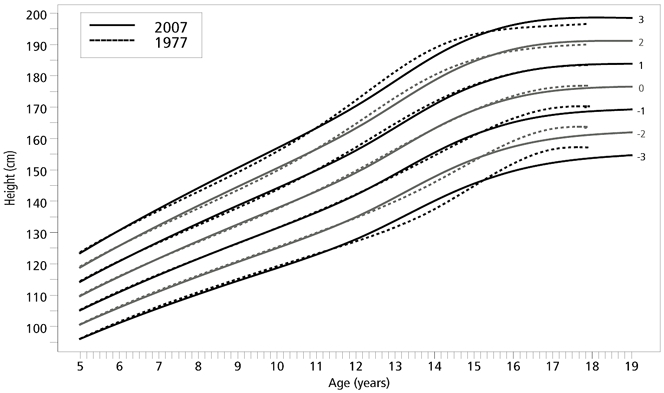
Comparison between the 1977 and 2007 height-for-age z-score curves – boys
Fig. 2.
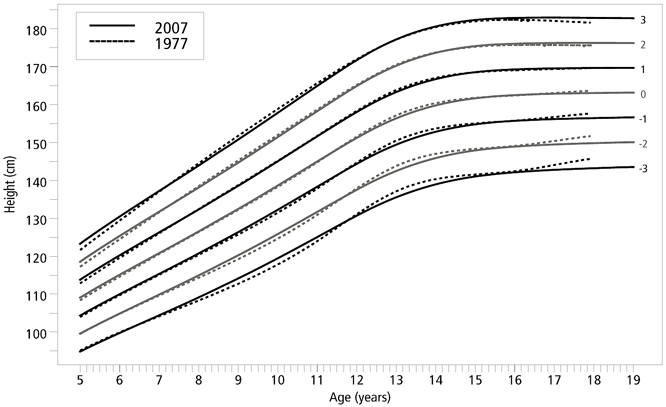
Comparison between the 1977 and 2007 height-for-age z-score curves – girls
Although the disparity at 5 years between the two sets of girls’ curves (Fig. 2) is greater than that observed for boys, ranging between 0.2 cm (–3 SD) and 1.7 cm (+3 SD), the curve shapes in later years follow more comparable patterns and culminate in a more similar distribution of attained height z-scores between 15 and 18 years of age. As observed for boys, the negative SDs and median of the 1977 set at 18 years are higher than their equivalent 2007 curves by 2.6 cm (–3 SD), 2.0 cm (–2 SD), 1.2 cm (–1 SD) and 0.6 cm (median). The +1 SD curves overlap at 18 years, and in reverse pattern to the negative SDs, the 1977 curves are lower by 0.7 cm (+2 SD) and 1.3 cm (+3 SD).
Weight-for-age
In the lower half of the weight-for-age distribution, the largest difference between the 1977 and 2007 boys’ curves (Fig. 3) is at 10 years of age, where the 2007 curves are higher by 2.9 kg (–3 SD) and 1.1 kg (–2 SD). In the upper half of the distribution, the largest disparities between the +1 SD and +2 SD curves are also at age 10 years, but in this case the 1977 curves are higher by 1.7 kg and 1.0 kg. The +3 SD curves present sizeable differences, with the 1977 curve being consistently lower throughout the age range (from 1.6 kg at 5 years to 3.1 kg at 10 years). Girls present similar patterns to those observed for boys (Fig. 4). At the lower bound, disparities are larger for girls than they are for boys. For girls at 10 years, the 2007 curves are higher by 3.7 kg (–3 SD) and 1.4 kg (–2 SD). At the upper bound, the largest disparity for the +3 SD curves is at 5 years, where the 2007 curve is 3.1 kg above the 1977 curve, but the difference decreases to 1.7 kg at 10 years. The +2 SD curves cross between 8 and 9 years. At 5 years, the 2007 curve is higher by 1.3 kg and, at 10 years, it is lower than the 1977 curve by 2.3 kg.
Fig. 3.
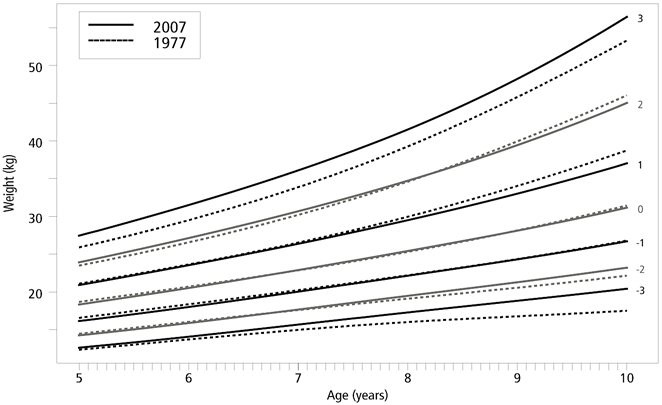
Comparison between the 1977 and 2007 weight-for-age z-score curves – boys
Fig. 4.
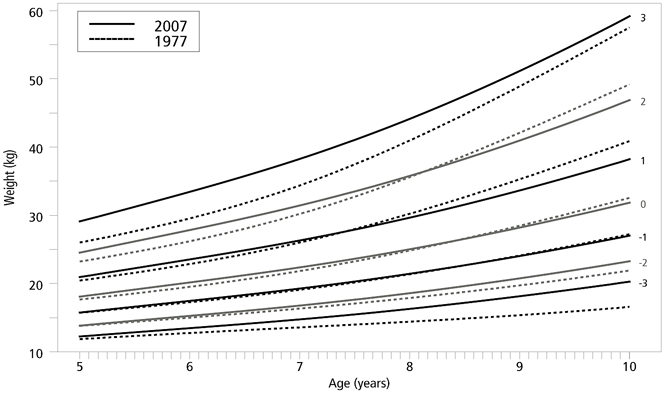
Comparison between the 1977 and 2007 weight-for-age z-score curves – girls
BMI-for-age
Fig. 5 (boys) and Fig. 6 (girls) show the reference data for BMI-for-age developed in 1991 that WHO has to date recommended for ages 9 to 24 years6 and how they compare with corresponding centiles of the newly constructed curves in the age period where the two sets overlap (9–19 years). The 5th, 15th and 50th percentiles for boys (Fig. 5) start at 9 years with small differences (0.1 kg/m² and 0.2 kg/m²) between the 1991 reference values and the 2007 curves. The two sets then track closely and cross over at about 17 years, so that by 19 years the 2007 percentiles are 0.3 kg/m² or 0.4 kg/m² higher than the 1991 reference values. The 85th percentile of the 1991 reference originates at 0.9 kg/m² above its 2007 equivalent and tracks above it to end at 0.8 kg/m² higher at 19 years. For the 95th percentile, the 1991 reference starts at 2.0 kg/m² higher and veers upwards, terminating 2.6 units above the 2007 curve at 19 years. The patterns observed in the boys’ curves are also evident among girls (Fig. 6), except that the crossover of the 5th, 15th and 50th percentiles occurs at 13 years, and differences in the 50th and 95th percentiles are slightly larger than corresponding differences in the boys’ percentiles. A wiggly pattern is noticeable in the 1991 reference values, particularly in the 50th, 85th and 95th percentiles.
Fig. 5.
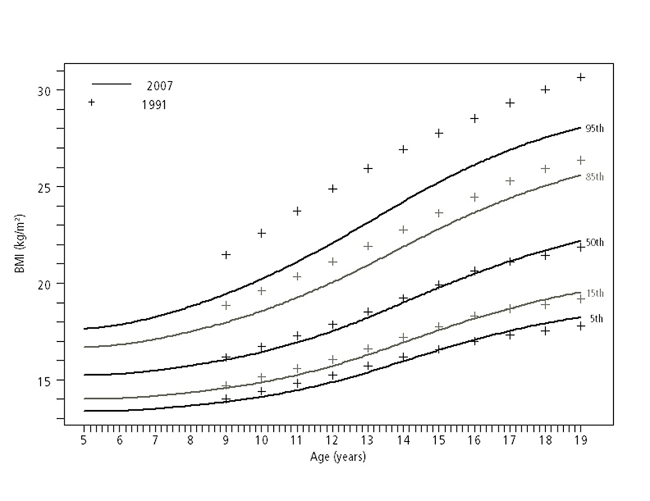
Comparison between the 1991 and 2007 body mass index-for-age percentile curves – boys
Fig. 6.
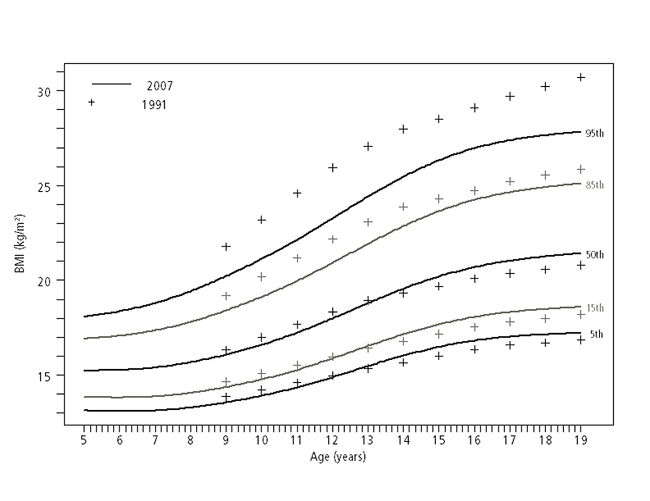
Comparison between the 1991 and 2007 body mass index-for-age percentile curves – girls
At 19 years of age, the 2007 BMI values at +1 SD are 25.4 kg/m² for boys and 25.0 kg/m² for girls, while the +2 SD values are 29.7 kg/m² for both sexes.
Transition to the 2007 WHO reference at 5 years
A main objective for reconstructing the 1977 NCHS/WHO reference was to provide a smooth transition from the WHO standard curves for under-fives to the reference curves for older children. Table 1 presents values at 5 years for the various indicators by sex of the 1977 and 2007 references for school-aged children and adolescents, and the WHO standards for under-fives.
Table 1. Reference values for height-for-age, weight-for-age and body mass index-for-age at 5 years by sex for the 1977 and 2007 references, and the WHO Child Growth Standards.
| 1977 reference | 2007 reference | WHO standardsa | 1977 reference | 2007 reference | WHO standardsa | ||
|---|---|---|---|---|---|---|---|
|
Z-scores |
Boys |
Girls |
|||||
|
Height-for-age (cm) |
|||||||
| –3 SD | 96.1 | 96.0 | 96.1 | 95.1 | 94.9 | 95.2 | |
| –2 SD | 100.7 | 100.6 | 100.7 | 99.5 | 99.6 | 99.9 | |
| –1 SD | 105.3 | 105.2 | 105.3 | 104.0 | 104.3 | 104.7 | |
| Median | 109.9 | 109.7 | 110.0 | 108.4 | 109.1 | 109.4 | |
| +1 SD | 114.5 | 114.3 | 114.6 | 112.8 | 113.8 | 114.2 | |
| +2 SD | 119.1 | 118.8 | 119.2 | 117.2 | 118.6 | 118.9 | |
|
+3 SD |
123.7 |
123.4 |
123.9 |
121.6 |
123.3 |
123.7 |
|
|
Weight-for-age (kg) |
|||||||
| –3 SD | 12.3 | 12.6 | 12.4 | 11.9 | 12.2 | 12.1 | |
| –2 SD | 14.4 | 14.2 | 14.1 | 13.8 | 13.8 | 13.7 | |
| –1 SD | 16.6 | 16.1 | 16.0 | 15.7 | 15.8 | 15.8 | |
| Median | 18.7 | 18.3 | 18.3 | 17.7 | 18.1 | 18.2 | |
| +1 SD | 21.1 | 20.9 | 21.0 | 20.4 | 21.0 | 21.2 | |
| +2 SD | 23.5 | 23.9 | 24.2 | 23.2 | 24.5 | 24.9 | |
|
+3 SD |
25.9 |
27.5 |
27.9 |
26.0 |
29.1 |
29.5 |
|
|
Body mass index-for-age (kg/m²)b |
|||||||
| –3 SD | – | 12.1 | 12.0 | – | 11.8 | 11.6 | |
| –2 SD | – | 13.0 | 12.9 | – | 12.8 | 12.7 | |
| –1 SD | – | 14.1 | 14.0 | – | 13.9 | 13.9 | |
| Median | – | 15.3 | 15.2 | – | 15.2 | 15.3 | |
| +1 SD | – | 16.6 | 16.6 | – | 16.9 | 16.9 | |
| +2 SD | – | 18.2 | 18.3 | – | 18.8 | 18.8 | |
| +3 SD | – | 20.1 | 20.3 | – | 21.3 | 21.1 | |
Disparities between the 1977 reference and the WHO height-for-age and weight-for-age standards for girls at 5 years were larger than those observed in corresponding boys’ curves. For example, the differences in the boys’ height-for-age curves were at most 0.2 cm, in contrast to the girls’ curves that were disparate by as much as 1.7 cm and 2.1 cm at +2 and +3 SD, respectively. For weight-for-age, differences between the 1977 reference and the WHO standards at +3 SD were 2.0 kg for boys and 3.5 kg for girls. Since no NCHS-based reference values for BMI were available for ages below 9 years, the table presents comparative values only for the 2007 reconstructed reference and the WHO standards at 5 years of age.
The reconstruction resulted in curves that are closely aligned to corresponding WHO standards at the junction (5 years). For height-for-age boys, the three negative SDs are only 0.1 cm apart, the median and +1 SD curves differ by 0.3 cm, and disparities at +2 SD and +3 SD are 0.4 cm and 0.5 cm, respectively. For girls, the differences between the two sets of curves are 0.3 cm or 0.4 cm through the full range of z-scores. For weight-for-age, where differences between the 1977 reference and the WHO standards at 5 years were considerable, the reconstruction substantially reduced differences in the final curves. The boys’ medians are equal, while their negative z-scores differ by 0.1 kg or 0.2 kg, and the positive z-scores by 0.1 kg (+1 SD), 0.3 kg (+2 SD) and 0.4 kg (+3 SD). Residual differences in the two sets of curves for girls are in a range similar to those in the boys’ curves, which is between 0.0 kg and 0.4 kg.
The merger of the under-fives growth standards’ data (18–71 months) with the NCHS core sample to fit the 2007 curves for school-aged children and adolescents resulted in a very smooth transition between the WHO Child Growth Standards and the newly constructed references for BMI-for-age. For both boys and girls, differences between the two curve sets at 5 years are mostly 0.0 kg/m² or 0.1 kg/m², and never more than 0.2 kg/m².
Discussion
The need for a widely applicable growth reference for older children and adolescents was increasingly recognized by countries attempting to assess the magnitude of the growing public health problem of childhood obesity. This need was reaffirmed by the release of the under-five growth standards. The reconstruction presented in this paper has resulted in growth curves that are closely aligned to the WHO Child Growth Standards at 5 years and as such are a suitable complementary reference for use in school-aged child and adolescent health programmes. The various clinical charts and tables provided on the Internet will allow for the practical application of the reference.
The approach used in constructing the 2007 WHO reference addressed the limitations of the 1977 NCHS curves recognized by the 1993 expert committee4 that recommended their provisional use for older children. The height-for-age median curves of the 1977 and 2007 references overlap almost completely with only a slight difference in shape, which is probably due to the different modelling techniques used. For the 1977 NCHS/WHO curves, age-specific standard deviations from the median were derived from the observed dispersion of six percentile curves (5th, 10th, 25th, 75th, 90th and 95th) and then smoothed by a combination of polynomial regression and cubic splining techniques.14 In the 2007 reconstruction, age was modelled as a continuous variable, and the curves were fitted simultaneously and smoothed throughout the age range using cubic splines. Furthermore, edge effects were avoided by constructing the 2007 curves with data that extended beyond the lower and upper age bounds of the final reference curves. The latter may explain why the 1977 NCHS/WHO curves have pronounced wiggly shapes towards the upper age limit of the reference compared with the 2007 curves.
When compared to the 1977 NCHS/WHO curves, the differences in the newly reconstructed weight-for-age curves are significant in all centiles apart from the median and the –1 SD curves, reflecting the important difference in curve construction methodology. The fact that the median curves of the two references overlap almost completely is reassuring in that the two samples used for fitting the models are the same within the healthy range (i.e. middle range of the distribution). The methodology available at the time of constructing the 1977 curves was limited in its ability to model skewed data.14 Fixing a higher standard deviation distance between the curves above the median and a lower one for the curves below, as was done, partially accounted for the skewness in the weight data but failed to model the progressively increasing distances between the SD curves from the lower to the upper tails of the weight-for-age distribution. To fit the skewed data adequately, the LMS method (used in the construction of the 2007 curves and other recently developed weight-based references) fits a Box-Cox normal distribution, which follows the empirical data closely.15–17
The reference data for BMI-for-age recommended by WHO are limited in that they begin only at 9 years of age and cover a restricted distribution range (5th–95th percentiles). The empirical reference values were estimated using data that were grouped by age in years, and then smoothed using locally weighted regression.6 The 2007 reconstruction permits the extension of the BMI reference to 5 years, where the curves match WHO under-five curves almost perfectly. Furthermore, at 19 years of age, the 2007 BMI values for both sexes at +1 SD (25.4 kg/m² for boys and 25.0 kg/m² for girls) are equivalent to the overweight cut-off used for adults (≥ 25.0 kg/m²), while the +2 SD value (29.7 kg/m² for both sexes) compares closely with the cut-off for obesity (≥ 30.0 kg/m²).18
The 2007 height-for-age and BMI-for-age charts extend to 19 years, which is the upper age limit of adolescence as defined by WHO.19 The weight-for-age charts extend to 10 years for the benefit of countries that routinely measure only weight and would like to monitor growth throughout childhood. Weight-for-age is inadequate for monitoring growth beyond childhood due to its inability to distinguish between relative height and body mass, hence the provision here of BMI-for-age to complement height-for-age in the assessment of thinness (low BMI-for-age), overweight and obesity (high BMI-for-age) and stunting (low height-for-age) in school-aged children and adolescents. ■
Footnotes
Competing interests: None declared.
References
- 1.Lobstein T, Baur L, Uauy R. IASO International Obesity Task Force. Obesity in children and young people: a crisis in public health. Obes Rev. 2004;5:4–104. doi: 10.1111/j.1467-789X.2004.00133.x. [DOI] [PubMed] [Google Scholar]
- 2.WHO Multicentre Growth Reference Study Group WHO Child Growth Standards based on length/height, weight and age. Acta Paediatr Suppl. 2006;450:76–85. doi: 10.1111/j.1651-2227.2006.tb02378.x. [DOI] [PubMed] [Google Scholar]
- 3.De Onis M. The use of anthropometry in the prevention of childhood overweight and obesity. Int J Obes Relat Metab Disord. 2004;28:S81–5. doi: 10.1038/sj.ijo.0802810. [DOI] [PubMed] [Google Scholar]
- 4.Physical status: the use and interpretation of anthropometry. Report of a WHO Expert Committee. World Health Organ Tech Rep Ser. 1995;854:161–262. [PubMed] [Google Scholar]
- 5.Wang Y, Moreno LA, Caballero B, Cole TJ. Limitations of the current World Health Organization growth references for children and adolescents. Food Nutr Bull. 2006;27:S175–88. doi: 10.1177/15648265060274S502. [DOI] [PubMed] [Google Scholar]
- 6.Must A, Dallal GE, Dietz WH. Reference data for obesity: 85th and 95th percentiles of body mass index (wt/ht²) and triceps skinfold thickness. Am J Clin Nutr. 1991;53:839–46. doi: 10.1093/ajcn/53.4.839. [DOI] [PubMed] [Google Scholar]
- 7.Butte NF, Garza C.editorsDevelopment of an international growth standard for preadolescent and adolescent children. Food Nutr Bull 200627S169–326. [DOI] [PubMed] [Google Scholar]
- 8.Butte NF, Garza C, de Onis M. Evaluation of the feasibility of international growth standards for school-aged children and adolescents. J Nutr. 2007;137:153–7. doi: 10.1093/jn/137.1.153. [DOI] [PubMed] [Google Scholar]
- 9.Borghi E, de Onis M, Garza C, Van den Broeck J, Frongillo EA, Grummer-Strawn L, et al. for theWHO Multicentre Growth Reference Study Group. Construction of the World Health Organization child growth standards: selection of methods for attained growth curves. Stat Med 200625247–65. 10.1002/sim.2227 [DOI] [PubMed] [Google Scholar]
- 10.WHO Multicentre Growth Reference Study Group. WHO Child Growth Standards: length/height-for-age, weight-for-age, weight-for-length, weight-for-height and body mass index-for-age: methods and development. Geneva: WHO; 2006. [Google Scholar]
- 11.Hamill PV, Drizd TA, Johnson CL, Reed RB, Roche AF. NCHS growth curves for children birth-18 years: United States. Vital Health Stat 11. 1977;165:i–iv, 1-74. [PubMed] [Google Scholar]
- 12.Rigby RA, Stasinopoulos DM. Smooth centile curves for skew and kurtotic data modelled using the Box-Cox power exponential distribution. Stat Med. 2004;23:3053–76. doi: 10.1002/sim.1861. [DOI] [PubMed] [Google Scholar]
- 13.Cole TJ, Green PJ. Smoothing reference centile curves: the LMS method and penalized likelihood. Stat Med. 1992;11:1305–19. doi: 10.1002/sim.4780111005. [DOI] [PubMed] [Google Scholar]
- 14.Dibley MJ, Goldsby JB, Staehling NW, Trowbridge FL. Development of normalized curves for the international growth reference: historical and technical considerations. Am J Clin Nutr. 1987;46:736–48. doi: 10.1093/ajcn/46.5.736. [DOI] [PubMed] [Google Scholar]
- 15.Kuczmarski RJ, Ogden CL, Guo SS, Grummer-Strawn LM, Flegal KM, Mei Z, et al. 2000 CDC growth charts for the United States: methods and development. Vital Health Stat 11. 2002;246:1–190. [PubMed] [Google Scholar]
- 16.Cole TJ, Freeman JV, Preece MA. British 1990 growth reference centiles for weight, height, body mass index and head circumference fitted by maximum penalized likelihood. Stat Med. 1998;17:407–29. doi: 10.1002/(SICI)1097-0258(19980228)17:4<407::AID-SIM742>3.0.CO;2-L. [DOI] [PubMed] [Google Scholar]
- 17.Fredriks AM, van Buuren S, Burgmeijer RJ, Meulmeester JF, Beuker RJ, Brugman E, et al. Continuing positive secular growth change in the Netherlands 1955-1997. Pediatr Res. 2000;47:316–23. doi: 10.1203/00006450-200003000-00006. [DOI] [PubMed] [Google Scholar]
- 18.Obesity: preventing and managing the global epidemic. Report of a WHO consultation. World Health Organ Tech Rep Ser. 2000;894:1–253. [PubMed] [Google Scholar]
- 19.Young people’s health — a challenge for society. Report of a WHO Study Group on young people and Health for All by the Year 2000. World Health Organ Tech Rep Ser. 1986;731:1–117. [PubMed] [Google Scholar]


